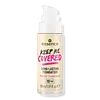Too Faced Born This Way Super Coverage Multi-Use Concealer Versus Essence Keep Me Covered Long-Lasting Foundation
What's inside
What's inside
 Key Ingredients
Key Ingredients

 Benefits
Benefits

 Concerns
Concerns

 Ingredients Side-by-side
Ingredients Side-by-side

Water
Skin ConditioningCyclopentasiloxane
EmollientButylene Glycol Dicaprylate/Dicaprate
EmollientTriethylhexanoin
MaskingIsoamyl Laurate
EmollientMethyl Trimethicone
Skin ConditioningPentylene Glycol
Skin ConditioningPolyglyceryl-4 Diisostearate/Polyhydroxystearate/Sebacate
EmulsifyingHydrogenated Starch Hydrolysate
HumectantCetyl PEG/PPG-10/1 Dimethicone
EmulsifyingTrimethylsiloxysilicate
EmollientSilica
AbrasivePerfluorooctyl Triethoxysilane
Aluminum Hydroxide
EmollientHydroxyacetophenone
AntioxidantSodium Chloride
MaskingDisteardimonium Hectorite
StabilisingDimethicone
EmollientAcrylates/Polytrimethylsiloxymethacrylate Copolymer
Skin Conditioning1,2-Hexanediol
Skin ConditioningCaprylyl Glycol
EmollientDimethicone/Vinyl Dimethicone Crosspolymer
Skin ConditioningTrisodium Ethylenediamine Disuccinate
Glycerin
HumectantCocos Nucifera Water
MaskingSodium Hyaluronate
HumectantCocos Nucifera Fruit Juice
EmollientRhododendron Ferrugineum Extract
MaskingPotassium Sorbate
PreservativeSodium Benzoate
MaskingCI 77891
Cosmetic ColorantIron Oxides
Water, Cyclopentasiloxane, Butylene Glycol Dicaprylate/Dicaprate, Triethylhexanoin, Isoamyl Laurate, Methyl Trimethicone, Pentylene Glycol, Polyglyceryl-4 Diisostearate/Polyhydroxystearate/Sebacate, Hydrogenated Starch Hydrolysate, Cetyl PEG/PPG-10/1 Dimethicone, Trimethylsiloxysilicate, Silica, Perfluorooctyl Triethoxysilane, Aluminum Hydroxide, Hydroxyacetophenone, Sodium Chloride, Disteardimonium Hectorite, Dimethicone, Acrylates/Polytrimethylsiloxymethacrylate Copolymer, 1,2-Hexanediol, Caprylyl Glycol, Dimethicone/Vinyl Dimethicone Crosspolymer, Trisodium Ethylenediamine Disuccinate, Glycerin, Cocos Nucifera Water, Sodium Hyaluronate, Cocos Nucifera Fruit Juice, Rhododendron Ferrugineum Extract, Potassium Sorbate, Sodium Benzoate, CI 77891, Iron Oxides
Water
Skin ConditioningIsododecane
EmollientC13-15 Alkane
SolventPolyglyceryl-4 Diisostearate/Polyhydroxystearate/Sebacate
EmulsifyingC12-15 Alkyl Benzoate
AntimicrobialZinc Stearate
Cosmetic ColorantPropanediol
SolventMagnesium Sulfate
Pentylene Glycol
Skin ConditioningTocopherol
AntioxidantEthylene Brassylate
Masking1,2-Hexanediol
Skin ConditioningDisteardimonium Hectorite
StabilisingCaprylhydroxamic Acid
Silica
AbrasiveLecithin
EmollientPropylene Carbonate
SolventStearic Acid
CleansingSodium Chloride
MaskingAscorbyl Palmitate
AntioxidantAluminum Starch Octenylsuccinate
AbsorbentCitric Acid
BufferingCI 77491
Cosmetic ColorantCI 77492
Cosmetic ColorantCI 77499
Cosmetic ColorantCI 77891
Cosmetic ColorantWater, Isododecane, C13-15 Alkane, Polyglyceryl-4 Diisostearate/Polyhydroxystearate/Sebacate, C12-15 Alkyl Benzoate, Zinc Stearate, Propanediol, Magnesium Sulfate, Pentylene Glycol, Tocopherol, Ethylene Brassylate, 1,2-Hexanediol, Disteardimonium Hectorite, Caprylhydroxamic Acid, Silica, Lecithin, Propylene Carbonate, Stearic Acid, Sodium Chloride, Ascorbyl Palmitate, Aluminum Starch Octenylsuccinate, Citric Acid, CI 77491, CI 77492, CI 77499, CI 77891
 Reviews
Reviews

Ingredients Explained
These ingredients are found in both products.
Ingredients higher up in an ingredient list are typically present in a larger amount.
1,2-Hexanediol is a synthetic liquid and another multi-functional powerhouse.
It is a:
- Humectant, drawing moisture into the skin
- Emollient, helping to soften skin
- Solvent, dispersing and stabilizing formulas
- Preservative booster, enhancing the antimicrobial activity of other preservatives
Ci 77891 is a white pigment from Titanium dioxide. It is naturally found in minerals such as rutile and ilmenite.
It's main function is to add a white color to cosmetics. It can also be mixed with other colors to create different shades.
Ci 77891 is commonly found in sunscreens due to its ability to block UV rays.
Learn more about CI 77891Disteardimonium Hectorite comes from the clay mineral named hectorite. It is used to add thickness to a product.
It can also help stabilize a product by helping to disperse other ingredients.
Hectorite is a rare, white clay mineral.
Learn more about Disteardimonium HectoritePentylene glycol is typically used within a product to thicken it. It also adds a smooth, soft, and moisturizing feel to the product. It is naturally found in plants such as sugar beets.
The hydrophilic trait of Pentylene Glycol makes it a humectant. As a humectant, Pentylene Glycol helps draw moisture from the air to your skin. This can help keep your skin hydrated.
This property also makes Pentylene Glycol a great texture enhancer. It can also help thicken or stabilize a product.
Pentylene Glycol also acts as a mild preservative and helps to keep a product microbe-free.
Some people may experience mild eye and skin irritation from Pentylene Glycol. We always recommend speaking with a professional about using this ingredient in your routine.
Pentylene Glycol has a low molecular weight and is part of the 1,2-glycol family.
Learn more about Pentylene GlycolPolyglyceryl-4 Diisostearate/Polyhydroxystearate/Sebacate isn't fungal acne safe.
Silica, also known as silicon dioxide, is a naturally occurring mineral. It is used as a fine, spherical, and porous powder in cosmetics.
Though it has exfoliant properties, the function of silica varies depending on the product.
The unique structure of silica enhances the spreadability and adds smoothness, making it a great texture enhancer.
It is also used as an active carrier, emulsifier, and mattifier due to its ability to absorb excess oil.
In some products, tiny microneedles called spicules are made from silica or hydrolyzed sponge. When you rub them in, they lightly polish away dead skin layers and enhance the penetration of active ingredients.
Learn more about SilicaChances are, you eat sodium chloride every day. Sodium Chloride is also known as table salt.
This ingredient has many purposes in skincare: thickener, emulsifier, and exfoliator.
You'll most likely find this ingredient in cleansers where it is used to create a gel-like texture. As an emulsifier, it also prevents ingredients from separating.
There is much debate on whether this ingredient is comedogenic. The short answer - comedogenic ratings don't tell the whole story. Learn more about comegodenic ratings here.
The concensus about this ingredient causing acne seems to be divided. Research is needed to understand if this ingredient does cause acne.
Scrubs may use salt as the primary exfoliating ingredient.
Learn more about Sodium ChlorideWater. It's the most common cosmetic ingredient of all. You'll usually see it at the top of ingredient lists, meaning that it makes up the largest part of the product.
So why is it so popular? Water most often acts as a solvent - this means that it helps dissolve other ingredients into the formulation.
You'll also recognize water as that liquid we all need to stay alive. If you see this, drink a glass of water. Stay hydrated!
Learn more about Water